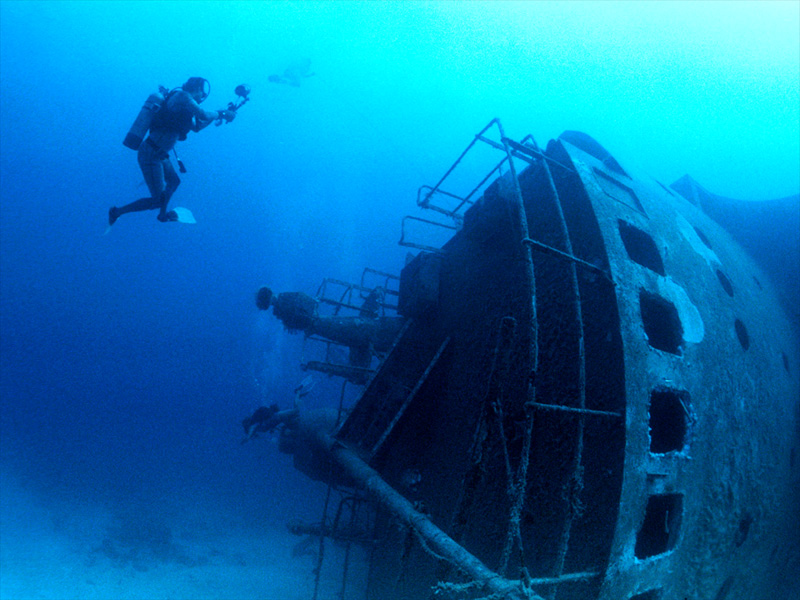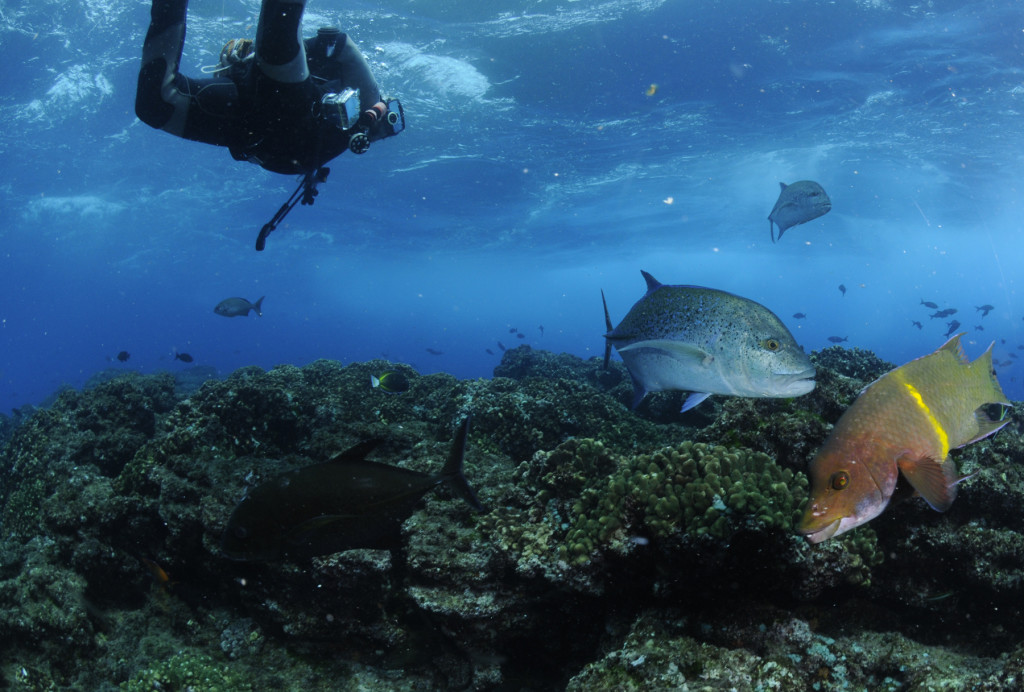Technical nitrox is defined as any nitrogen-oxygen mixture that contains more than EAN50 (50% oxygen). It tastes like air. It breathes like air. You must use oxygen-clean regulators and cylinders, but that is no different than advanced nitrox (EAN41 to EAN50 mixtures). So why is it considered “technical?”
Words and photos by Jeffrey Bozanic
Use of Technical Nitrox
Technical nitrox is often used during decompression diving to reduce decompression time. Some decompression schedules may be reduced by as much as two-thirds if a nitrox mixture containing high percentage oxygen is used when compared to breathing air. This benefit can be even greater compared to the diver who is using their helium-based breathing mixture for decompression as well as the deep portion of the dive. While decompression is considered technical, there are other uses of technical nitrox as well.
Divers have used rich nitrox mixtures (those with more than 50% oxygen) to increase bottom times while avoiding decompression. At 55 fsw, US Navy air dive tables allow a 74 minute no-decompression dive. EAN52 allows a diver to double their no-decompression time to 150 minutes, simultaneously remaining within oxygen toxicity limits. Apart from the high fraction mix in use, neither the open circuit equipment nor the depth would indicate this is a technical dive.

Using rich nitrox mixtures in intermediate depth ranges can significantly extend no decompression limits
Maintaining Depth in Air and Nitrox Diving
If you learned to dive using dive tables, you learned you must remain within a depth limit. This depth was set during the dive planning process. You also learned to establish a contingency plan, in case you inadvertently drifted past the planned maximum depth. Depth schedules on dive tables are usually listed in 10 fsw intervals. So, if you plan a dive to 70 fsw, your contingency plan is for 80 fsw. Implicit in the dive planning process is this: you are expecting your skill level is such that you will not vary more than 10 fsw.
We have a similar implied skill expectation in nitrox diving. With nitrox diving, depth intervals are defined by PO2 (partial pressure of oxygen). This derives from our need to monitor oxygen exposure. The NOAA Oxygen Exposure Time Limit Table, which we use to calculate this, has PO2 intervals of 0.1 atm. Thus, as certified nitrox divers, we must be able to maintain our depth to within 0.1 atm PO2. What does this mean in feet?
We can determine this for any given nitrox mixture by looking at the variation in depth calculated for any two PO2s differing by 0.1 atm. Let’s do this for EAN32 (FO2 = 0.32, the fraction equivalent of 32% oxygen), probably the most commonly used recreational nitrox mix. We can use PO2s of 1.0 atm and 1.1 atm. To calculate the depth at which we obtain a desired PO2, we use the following equation:
The depth turns out to be 70 fsw. When we calculate this for a PO2 of 1.1 atm, we get 80 fsw. The difference between the two values is 10 fsw. Coincidentally, this is exactly the same as the intervals we follow for air diving when looking at dive tables. Thus, the implied skill abilities of depth monitoring and buoyancy control are identical when using EAN32 or air in scuba diving.
Maintaining Depth in Technical Nitrox Diving
The same process can be used to calculate allowable depth variations with other nitrox mixtures. Other commonly used nitrox mixtures include EAN36, EAN40 (the limit allowed by a standard nitrox certification), EAN50 (the limit allowed by an advanced nitrox certification), EAN80, and 100% oxygen (the limit allowed with a technical nitrox certification). This work has been done for you, and is shown in the following table:
|
Gas Mixture |
Depth (fsw) PO2 = 1 atm |
Depth (fsw) PO2 = 1.1 atm |
Allowed Depth Variation (fsw) |
|
Air |
— |
— |
10 |
|
EAN32 |
70.1 |
80.4 |
10.3 |
|
EAN36 |
58.7 |
67.8 |
9.2 |
|
EAN40 |
49.5 |
57.8 |
8.3 |
|
EAN50 |
33.0 |
39.6 |
6.6 |
|
EAN80 |
8.3 |
12.4 |
4.1 |
|
Oxygen |
0 |
3.3 |
3.3 |
As you can see, the richer the nitrox mixture, the more important depth control becomes. As a certified diver, you should be able to control your depth to within 10 fsw. As a certified nitrox diver, you are expected to be able to control your depth to within 8 fsw. With an advanced nitrox certification, this drops to about 7 fsw. And finally, with a technical nitrox certification, you must be able to control your depth to within 3 fsw!
Strong surge can make it impossible to maintain a safe depth using rich nitrox mixtures
Implications of Technical Nitrox Use
Think back on your own diving career… have you ever found yourself deeper than planned? Perhaps even more than 10 fsw deeper than you had initially intended on going? Maintaining your depth to within 3 fsw can be extremely difficult. Even an exceptionally skilled diver may have difficulty in doing this in some conditions.
The ability to maintain depth is controlled by many factors: buoyancy control ability, depth monitoring ability, the duration necessary, equipment in use and your comfort and ability in using it, and environmental factors. Practice and experience can lead to the ability to do many of these effectively. You can learn to monitor your depth gauge or dive computer so you do not drift deeper than planned. Frequent dives will help you develop the ability to control your buoyancy. Practice with your BC, drysuit, double cylinders, lift bags, and other equipment will lead to proficiency and competency in maintaining depth. However, no amount of training or experience will allow you to control the environmental factors.
Depth control is predicated on depth measured from the surface. Strong currents, swells, wind chop, up or down-welling, and other environmental conditions can make it impossible to control depth to within three feet. You cannot stay within three feet while diving in the open ocean where you have ten-foot swells, for example. In fact, I have been in conditions where it is nearly impossible to maintain depth to within 20 fsw at times! So, also implicit in the use of technical nitrox mixtures is the judgment necessary to evaluate dive conditions prior to diving; selecting a mixture or mixtures appropriate for the environment.
Conclusion
Technical nitrox is considered “technical” primarily for two reasons. First, divers using it must have the skills required to maintain much tighter depth control than needed in most recreational diving. And second, they must have the experience and judgment to decide when environmental conditions do not allow the prudent use of rich nitrox mixtures.
Words and photos by Jeffrey Bozanic
About the Author:
Jeff Bozanic was certified as a NAUI Instructor in 1978, is certified to teach diving for the NSS-CDS, NACD, IANTD, TDI, and NAUI. He is active in teaching cave diving, rebreather, nitrox, technical nitrox, and trimix diving courses. He has published extensively on diving education topics, with heavy emphasis on cave diving safety techniques. He has edited/reviewed many diving textbooks, and is the author of Mastering Rebreathers. He has served on several Boards of Directors in the diving community, including as Chairman of the NSS-CDS and as Vice Chairman of NAUI, and as Treasurer on the AAUS Board. He has received the NAUI Outstanding and Continuing Service Awards; the Silver Wakulla, Abe Davis, Henry Nicholson, and International Cave Diving Awards for safe cave diving; the SSI Platinum Pro 5000 Award, and is a NAUI Hall of Honor inductee. In 2007 he was honored as the DAN/Rolex Diver of the Year. Jeff may be contacted at jeff@jeffbozanic.com.
.
.



